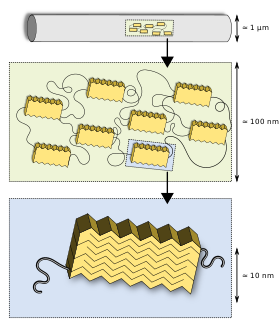Silk has always been known to be among the strongest natural protein fibers in existence, but spider silk in particular has remarkable properties, its tensile strength larger than that of steel and its flexibility enough to be woven into a web. More intriguingly, spider silk has been proven to be biocompatible, raising the question: can spider silk replace the protein keratine, which is currently used to provide strength in human skin?
Project 2.6g 329m/s answered this question by growing a patch of human skin that consisted of a spider silk matrix in between the dermis and epidermis. As the video below attests to, this artificial skin was even able to stop a bullet.
But what exactly about spider silk makes it so flexible and strong? The answer to this question lies in its chemical structure. Similar to Kevlar, spider silk is a combination of crystalline structures in an amorphous matrix. Its main protein is called fibroin, consisting primarily of the amino acids alanine and glycine. Fibroin has two differently structured regions that contribute to the tensile and elastic properties of silk.
 |
| Hydrogen-bonded polyalanine regions. |
In the glycine-rich spiral regions, a sequence of five amino acids is repeated over and over similar to the polyalanine regions, but the twist is that the molecule takes a 180 degree turn at the end of each sequence. This results in, as the name suggests, a spiral which is so densely twisted that some types of spider silk can even stretch up to 4 times its original length.
 |
| Crystalline regions juxtaposed with amorphous regions. |
Further contributing to the elasticity, the glycine-rich spiral regions comprise the amorphous areas of the silk. Somewhat less ordered polyalanine regions connect the amorphous areas to the more ordered polyalanine regions, resulting in an overall structure that is both immensely strong and surprisingly flexible.
No comments:
Post a Comment